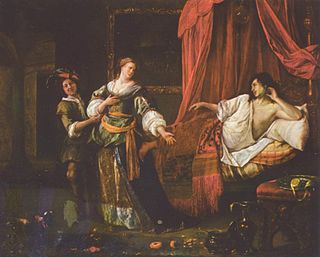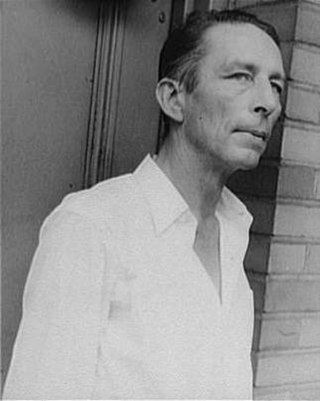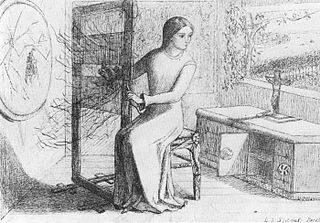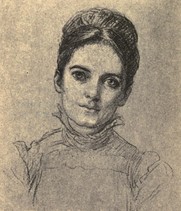
Absalom, according to the Hebrew bible, was an Israelite prince. Born to David and Maacah, who was from Geshur, he was the only full sibling of Tamar. He is described in the Hebrew Bible as being exceptionally beautiful, as is his sister. In the narrative of 2 Samuel 13, his sister Tamar takes refuge at his house after she is raped by their paternal half-brother Amnon ; David is angered by the incident, but does nothing, as Amnon is his heir apparent. Infuriated by the rape and David's inaction, Absalom assassinates Amnon and subsequently flees to Geshur, which is ruled by his and Tamar's maternal grandfather Talmai.

Amnon was, in the Hebrew Bible, the oldest son of King David and his second wife, Ahinoam of Jezreel. He was born in Hebron during his father's reign in Judah. He was the heir apparent to the throne of Israel until he was assassinated by his half-brother Absalom to avenge the rape of Absalom's sister Tamar.

Gary Snyder is an American poet, essayist, lecturer, and environmental activist. His early poetry has been associated with the Beat Generation and the San Francisco Renaissance and he has been described as the "poet laureate of Deep Ecology". Snyder is a winner of a Pulitzer Prize for Poetry and the American Book Award. His work, in his various roles, reflects an immersion in both Buddhist spirituality and nature. He has translated literature into English from ancient Chinese and modern Japanese. For many years, Snyder was an academic at the University of California, Davis, and for a time served as a member of the California Arts Council.

John Robinson Jeffers was an American poet known for his work about the central California coast.

"The Lady of Shalott" is a lyrical ballad by the 19th-century English poet Alfred Tennyson and one of his best-known works. Inspired by the 13th-century Italian short prose text Donna di Scalotta, the poem tells the tragic story of Elaine of Astolat, a young noblewoman stranded in a tower up the river from Camelot. Tennyson wrote two versions of the poem, one published in 1832, of 20 stanzas, the other in 1842, of 19 stanzas, and returned to the story in "Lancelot and Elaine". The vivid medieval romanticism and enigmatic symbolism of "The Lady of Shalott" inspired many painters, especially the Pre-Raphaelites and their followers, as well as other authors and artists.

Agnes Mary Frances Robinson was a poet, novelist, essayist, literary critic, and translator. She was the elder sister of the novelist and critic Frances Mabel Robinson.

Troilus and Criseyde is an epic poem by Geoffrey Chaucer which re-tells in Middle English the tragic story of the lovers Troilus and Criseyde set against a backdrop of war during the siege of Troy. It was written in rime royale and probably completed during the mid-1380s. Many Chaucer scholars regard it as the poet's finest work. As a finished long poem, it is more self-contained than the better known but ultimately unfinished The Canterbury Tales. This poem is often considered the source of the phrase: "all good things must come to an end" (3.615).

"The Idiot Boy" is a poem written by William Wordsworth, a representative of the Romantic movement in English literature. The poem was composed in spring 1798 and first published in the same year in Lyrical Ballads, a collection of poems written by Wordsworth and Samuel Taylor Coleridge, which is considered to be a turning point in the history of English literature and the Romantic movement. The poem investigates such themes as language, intellectual disability, maternity, emotionality, organisation of experience and "transgression of the natural."
William "Bill" Everson, also known as Brother Antoninus, was an American poet, literary critic, teacher and small press printer. He was a member of the San Francisco Renaissance.
Tamar is a female given name of Hebrew origin, meaning "date", "date palm" or just "palm tree". In the Bible, Tamar refers to two women: one is the daughter-in-law of Judah, Tamar, and the other is the daughter of King David and full sister of Absalom, Tamar. The latter was raped by her half-brother Amnon, leading Absalom to eventually kill him. Absalom named his daughter Tamar, described as a woman of great beauty. For a period, Tamar held the top spot for girls' names in Israel, and dropped to second in 2022.

Aileen Lucia Fisher was an American writer of more than a hundred children's books, including poetry, picture books in verse, prose about nature and America, biographies, Bible-themed books, plays, and articles for magazines and journals. Her poems have been anthologized many times and are frequently used in textbooks. In 1978 she was awarded the second National Council of Teachers of English Award for Excellence in Poetry for Children. Born in Michigan, Fisher moved to Colorado as an adult and lived there for the rest of her life.
Robert Michael Zaller is an American author whose works include volumes of history, criticism, and verse. He is Drexel Distinguished University Professor of History Emeritus, and has been active as an opponent of the death penalty.

The Lucy poems are a series of five poems composed by the English Romantic poet William Wordsworth (1770–1850) between 1798 and 1801. All but one were first published during 1800 in the second edition of Lyrical Ballads, a collaboration between Wordsworth and Samuel Taylor Coleridge that was both Wordsworth's first major publication and a milestone in the early English Romantic movement. In the series, Wordsworth sought to write unaffected English verse infused with abstract ideals of beauty, nature, love, longing, and death.
"Lucy Gray" is a poem written by William Wordsworth in 1799 and published in his Lyrical Ballads. It describes the death of a young girl named Lucy Gray, who went out one evening into a storm.

Tamar was an Israelite princess. Born to David and Maacah, who was from Geshur, she was the only full sibling of Absalom. She is described in the Hebrew Bible as being exceptionally beautiful, as is her brother. In the narrative of 2 Samuel 13, she is raped by her paternal half-brother Amnon before fleeing with torn robes to Absalom's house; David is angered by the incident, but does nothing, as Amnon is his heir apparent. Absalom, infuriated by the rape and David's inaction, keeps Tamar in his care and later assassinates Amnon to avenge her, subsequently fleeing to Geshur, which is ruled by his and Tamar's maternal grandfather Talmai. Three years later, he returns to Israel and leads an armed revolt against the House of David, but is killed by David's nephew and army commander Joab during the Battle of the Wood of Ephraim. Tamar is described as being left "a desolate women in her brother's house" and the sole guardian of her orphaned niece, who is also named Tamar.
Elizabeth Edwina Smither is a New Zealand poet and writer.

John Felstiner, was an American literary critic, translator, and poet. His interests included poetry in various languages, environmental and ecologic poems, literary translation, Vietnam era poetry and Holocaust studies. John Felstiner died in February 24, 2017 at the age of 80. He had been suffering from the effects of progressive aphasia at his time of death, at a hospice near Stanford.

Rosalind and Helen, A Modern Eclogue; With Other Poems is a poem collection by Percy Bysshe Shelley published in 1819. The collection also contains the poems "Lines written on the Euganean Hills", "Hymn to Intellectual Beauty", and the sonnet "Ozymandias". The collection was published by C. and J. Ollier in London.

"Birds and Fishes" is a poem by the American and Californian writer Robinson Jeffers. It is included in The Beginning and the End and Other Poems, published posthumously in 1963.
"Shine, Perishing Republic" is a poem by the American writer Robinson Jeffers, first published in 1925 in the collection Roan Stallion, Tamar, and Other Poems. It describes an increasingly corrupt American empire, which it advises readers to view through the naturalizing perspective of social cycles. Jeffers wrote two companion poems in the 1930s: "Shine, Republic" and "Shine, Empire".














